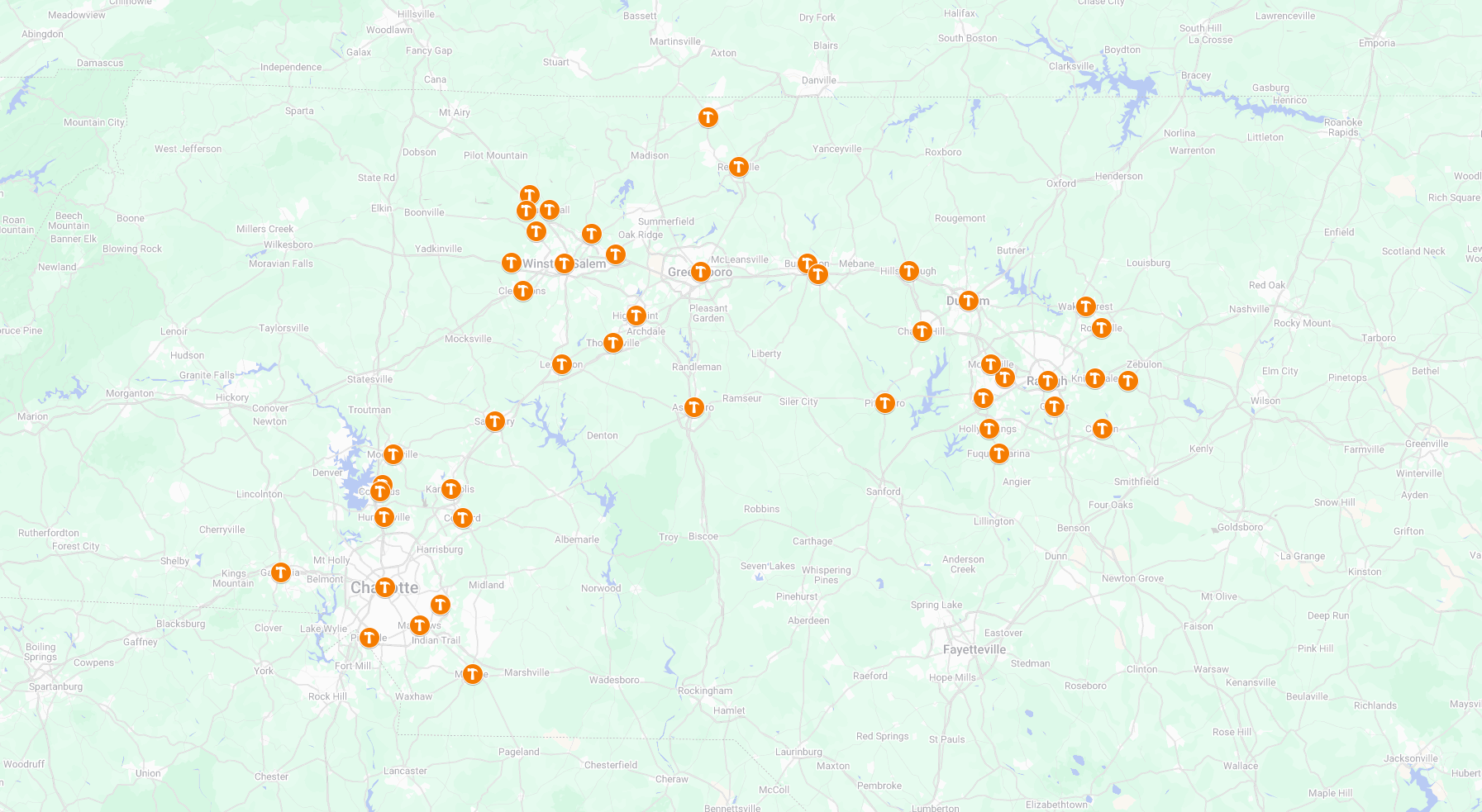Choosing a roof in the Tar Heel State isn’t as simple as flipping through a color chart. With salty coastal winds, humid summers, surprise hailstorms, and the occasional mountain snow, North Carolina weather can punish a poorly chosen material. At MJAK Contracting, we have repaired, replaced, and upgraded thousands of roofs from Wilmington to Raleigh to Boone, and we have seen firsthand which products thrive and which succumb prematurely. Below, we break down the best roofing materials for North Carolina homeowners, explain how each option holds up under our unique climate pressures, and highlight how every choice can pair seamlessly with a solar array for maximum long-term savings.

Understanding North Carolina’s Diverse Climate Challenges
Before picking a shingle, you need to understand what your roof will be up against:
- Heat & Humidity: Extended summers mean blistering UV exposure and persistent moisture that can accelerate shingle aging and foster algae growth.
- Coastal hurricanes: Winds that reach Category 1–3, challenging both material durability and roof integrity.
- Heavy Rain & Hail: Thunderstorms sweep across the Piedmont, dumping inches of rain and hail that can bruise vulnerable roofing surfaces.
- Freeze-Thaw Cycles: Especially in the foothills and mountains, daytime melts and nighttime freezes can crack rigid materials.
An optimal roofing material for North Carolina must address these challenges, and it also needs to support modern homeowner goals such as adding solar to lock in lower energy bills. Let’s explore the stand-out options.
Key Factors When Selecting a Roof in NC
- Wind Uplift Rating: Choose materials and fastening systems tested to at least 130 mph.
- Algae Resistance: Look for shingles with copper or zinc granules, or smooth metal surfaces that resist algae growth.
- Impact Resistance: Class 4 ratings provide the best protection against hail-induced damage.
- Cooling Potential: Lighter colors and reflective coatings help lower attic temperatures and reduce AC costs.
- Solar Compatibility: The roof should last as long as—or longer than—your photovoltaic (PV) system and allow for secure, leak-free attachment.
The Top Roofing Materials for North Carolina Homes
Asphalt Shingles: The Economical Choice
Continuing to be the preferred choice for North Carolinians, asphalt shingles offer a balanced combination of cost-effectiveness and durability. Asphalt shingles last between 25–30 years when installed and maintained correctly. Coastal communities, however, should choose corrosion-resistant fasteners and specific algae-resistant shingles to tackle the humidity.
Climate Performance: Premium lines carry enhanced wind warranties (up to 130 mph) and feature algae-fighting copper granules—ideal for humid regions where black streaks plague lesser brands.
Lifespan: 25–30 years when properly installed and ventilated.
Solar Factor: Asphalt shingles pair well with rail-mounted solar systems. We use flashed L-feet so panels can be removed or replaced without voiding shingle warranties.
Pros:
- Low upfront cost with vast design options
- Effortless installation and maintenance
- Compatible with typical solar roofing systems
Cons:
- Asphalt has limitations, particularly when exposed to prolonged heat and severe hail, which can cause accelerated granule loss.
Metal Roofing: The Durable Guardian
The adoption of metal roofing, particularly standing seam varieties, has surged, valued for its longevity and high resilience to extreme weather. Metal roofs’ reflective nature naturally aids in energy efficiency, fitting well with North Carolina’s intensive sunlight exposure.
Solar Integration: Standout features for solar installations include their clamping capability, which reduces the need for drilling into metal panels, safeguarding water tightness, and enhancing installation speed.
Climate Performance: High wind and impact ratings, plus stone-coated options that dampen rain noise.
Lifespan: 40–50 years.
Solar Factor: Hidden fastener systems allow simple attachment of conventional solar rails.
Pros:
- Exceptionally long lifespan compared to other materials
- Minimal maintenance with high recyclability
- Energy-saving “Cool Roof” colors
- Strong wind resistance, often exceeding 140 mph
Cons: The higher initial investment may deter some, alongside potential noise unless fitted with adequate underlayment.
Composite Shakes and Slates: The High-Performance Impersonator
Synthetic composite roofing offers the charm of cedar shakes or slate tiles without the upkeep. Made from durable polymers and mineral blends, these lightweight systems handle North Carolina’s humidity, storms, and intense sun with ease.
Climate Performance: Class 4 impact rated and engineered to resist hurricane-force winds, moisture, and cracking.
Lifespan: Lasts 40–50 years—longer than natural cedar or slate with fewer maintenance concerns.
Weight Advantage: Lighter than stone or clay, usually requiring no rafter reinforcement.
Solar Integration: Uniform tile thickness simplifies solar hardware installation.
Ideal For: Historic homes, mountain cabins, or anyone wanting a high-end look with durable performance.
Pros:
- Classic appearance with low maintenance
- Long lifespan and strong weather resistance
- Lightweight and solar-ready
Cons: Higher initial cost than asphalt shingles, but pays off in longevity and reliability
Natural Slate & Clay Tile: The Luxury Lifespan
Natural slate and clay tiles are the gold standard for beauty and longevity in roofing. These premium materials offer unmatched curb appeal and long-term value. Slate resists water absorption and freeze-thaw damage, while clay tiles maintain vibrant color despite decades of sun exposure. However, their weight requires special consideration.
Climate Performance: Slate is virtually impervious to water and freeze-thaw cycles, while clay stays colorfast despite UV bombardment.
Lifespan: 75–100+ years. In most cases, the copper flashings will need replacement long before the tiles.
Structural Requirement: Rafters often require reinforcement to handle the weight.
Solar Factor: Specialized mounting brackets allow us to replace individual tiles with flashed hooks, protecting the surrounding field.
Ideal For: Statement homes where long-term value and classic aesthetics justify the premium investment.
Pros:
- Unmatched longevity and curb appeal
- Extremely resistant to fire, pests, and weather extremes
- Colorfast materials that maintain beauty over time
Cons:
- High material and installation cost
- Heavy weight often requires structural upgrades
Repairs can be labor-intensive and costly
Cedar Shake & Shingle: The Natural Original
Cedar roofing provides rustic character and natural insulation, making it a favored choice for mountain cabins, lakeside homes, and eco-conscious builds. Cedar’s oils offer some resistance to rot and insects, but regular maintenance is essential, especially in humid climates like much of North Carolina.
Climate Performance: Cedar’s natural oils fight insects, but high humidity can shorten lifespan unless the roof is well-ventilated.
Lifespan: 20–30 years if regularly maintained with treatments and cleanings.
Solar Factor: We often add a solar “overlay” using elevated racking to maintain adequate airflow beneath panels and preserve shake integrity.
Ideal For: Homeowners committed to a genuine, eco-friendly look and willing to embrace maintenance.
Pros:
- Distinctive, organic appearance
- Renewable, eco-friendly material
- Natural thermal insulation properties
Cons:
- Requires routine maintenance to prevent decay
- Not ideal for very humid or fire-prone regions
Flat Roof Options: TPO & Modified Bitumen
Many North Carolina homes feature low-slope sections over porches, sunrooms, or additions. For these areas, single-ply membranes excel.
TPO: White, heat-welded seams reflect UV rays and resist ponding water.
Modified Bitumen: A rugged, asphalt-based material reinforced with fiberglass or polyester; perfect when foot traffic is expected.
Solar Factor: Ballasted or mechanically attached racking spreads the weight evenly, allowing for successful solar installs on flat surfaces.
Pros:
- UV-resistant and energy-efficient
- Durable under foot traffic and mechanical loads
- Affordable and quick to install
Cons:
- Shorter lifespan than pitched roofing systems
- Less aesthetically appealing
- Vulnerable to ponding water without proper slope and drainage
Roofing & Solar: Why They Belong in the Same Conversation
Installing solar on an aging roof is akin to icing a cake that’s past its sell-by date—sooner or later, you’ll be scraping everything off to start over. When you partner with MJAK Contracting, we analyze roof age, deck condition, and remaining warranty before we ever design your PV system. Here’s how a roof-and-solar mindset benefits you:
- Cost Efficiency: Bundling roof replacement with solar installation can qualify you for federal tax credits on the roofing work directly beneath the array.
- Watertight Assurance: As licensed roofers, we flash and seal penetrations to manufacturer specs—no finger-pointing between separate contractors.
- Lifespan Alignment: We recommend materials that outlast or match the 25-year solar performance warranty, eliminating premature tear-offs.
- Energy Savings: Reflective roofs and solar panels team up to reduce attic heat gain and offset electric bills.

MJAK Contracting: From Roofing Anxiety to Homeowner Confidence
We know a roofing project can feel overwhelming. Questions like “Do I really need a full replacement?” or “Will this roof handle both hurricanes and solar panels?” keep many homeowners in analysis paralysis. That’s where MJAK comes in. Think of us as your trusted guide:
- Comprehensive Inspections: We photograph every penetration, ridge, and valley, then review findings with you in plain English—not contractor jargon.
- Transparent Comparisons: Using side-by-side cost-of-ownership charts, we demonstrate how a 30-year architectural shingle may cost more over time than a 50-year metal roof once you factor in energy savings and fewer replacements.
- Manufacturer-Certified Crews: Whether it’s GAF, CertainTeed, or Englert, our installers have factory training to keep warranties intact.
- Integrated Solar Design: In-house NABCEP-certified designers ensure your solar production goals align with roof layout, shading, and utility regulations.
- Clean-Site Promise: Magnetic nail sweeps, daily trash removal, and courteous crews earn us five-star reviews project after project.
Frequently Asked Questions
How long should my roof last in North Carolina?
With proper installation and ventilation, premium architectural shingles can serve 25–30 years, while metal, synthetic, slate, and tile can exceed 50. Coastal salt exposure and poor attic airflow are the biggest lifespan killers.
Is metal roofing noisy when it rains?
Not when installed over solid decking with underlayment—modern metal feels comparable to asphalt in sound tests.
Will solar panels damage my roof?
No. When flashed and mounted correctly, solar attachments enhance weatherproofing. Panels actually shield the roof from UV and hail, extending shingle life beneath them.
What roofing colors perform best in NC heat?
Lighter shades and reflective coatings keep attics cooler. However, modern IR (infrared-reflective) pigments allow even darker colors to reflect significant heat.
Next Steps: Your Complimentary Roof & Solar Assessment with MJAK Contracting
Ready to protect your home and turn sunshine into savings? Here’s how easy it is:
- Schedule: Call (336) 933-4977 or book online for a free on-site consultation
- Assess: We inspect your roof, discuss material options, measure solar potential, and answer every question with the utmost transparency.
- Design: Our team delivers a written proposal with 3-D renderings and straightforward pricing, offering you the best roofing and solar solutions.
- Install: MJAK’s certified crews complete most roofing projects in one to two days, followed by seamless solar commissioning.
- Relax: Enjoy decades of protection, lower energy bills, and ongoing support from the MJAK family, ensuring you’ve made a smart investment.
Transform Your Roof. Transform Your Home with MJAK Contracting.
North Carolina’s climate may be unpredictable, but your roofing decision doesn’t have to be. From cost-effective architectural shingles to hurricane-defying standing seam metal, MJAK Contracting is ready to guide you toward the best roofing material for your unique location, budget, and solar ambitions. Let’s turn weather worries into lifetime confidence—one roof at a time. Call (336) 933-4977 or book online for a free on-site consultation
